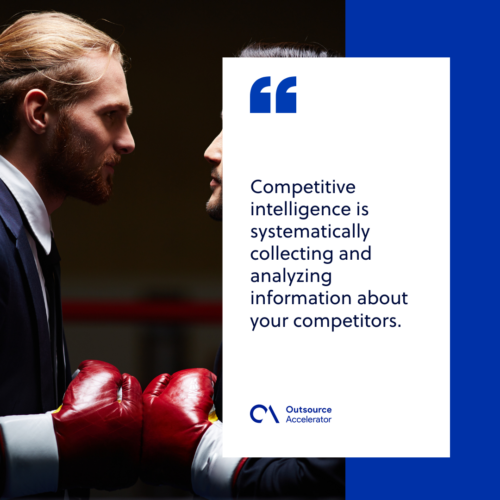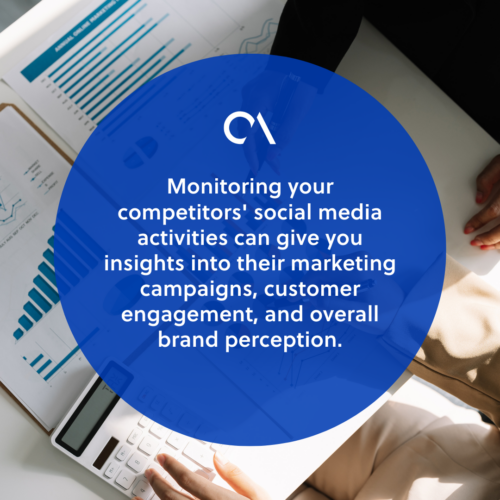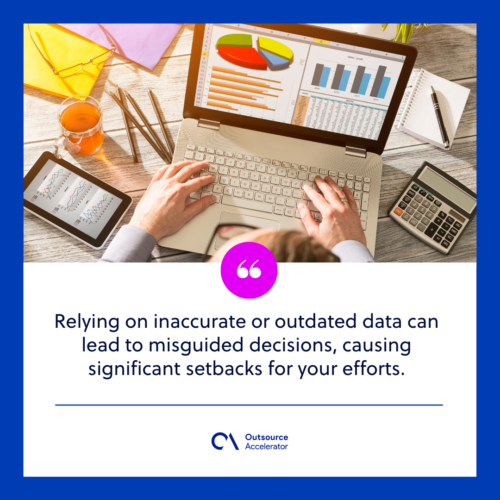Competitive intelligence for marketers: A comprehensive guide

Imagine you are a marketing executive for a leading smartphone manufacturer. Your company is about to launch a new flagship model, and you want it to outshine your competitors’ offerings.
To achieve this, you must understand what features, pricing, and marketing campaigns your rivals are executing.
This is where competitive intelligence becomes invaluable.
Competitive intelligence plays a pivotal role in the success of a business strategy across various industries. As a marketer, having a deep understanding of your competitors and their strategies is crucial for gaining a competitive edge.
This comprehensive guide will explore the concept of competitive intelligence and its significance for corporate intelligence and strategic decision-making.
What is competitive intelligence?
Competitive intelligence refers to the process of systematically collecting and analyzing information about your competitors.
Competitive intelligence programs go beyond the simple concept of knowing your competitors at face value. They provide a more detailed analysis of their services, marketing tactics, and overall business strategies.
Moreover, competitive intelligence covers how certain events can impact your competitors, from the stakeholders to their consumers.

Competitive intelligence activities are categorized into two types:
- Tactical competitive intelligence. Tactical competitive intelligence focuses on the immediate and short-term aspects of competition. It aims to provide inputs on issues such as increasing revenue and gaining market shares.
- Strategic competitive intelligence. Strategic competitive intelligence takes a broader and long-term perspective. It helps businesses formulate effective long-term strategies that shape their competitive advantage.
Why competitive intelligence is crucial for marketers
Competitive intelligence holds immense importance for marketers due to the following reasons:
Identifying market trends
You can identify emerging trends and market shifts by closely monitoring your competitors. This knowledge lets you adapt your processes accordingly and stay ahead of the curve.
Uncovering competitor strengths and weaknesses
Competitive intelligence helps you assess the strengths and weaknesses of your rivals. It helps identify areas where your products or services can outshine the competition.
Identifying untapped opportunities
By analyzing the strategies of your competitors, you can uncover untapped market opportunities. This helps you tailor your marketing strategies to address these gaps and gain a larger market share.
Staying proactive
With competitive intelligence, marketers can anticipate and proactively respond to competitor moves. This helps in mitigating risks and taking advantage of potential opportunities swiftly.
Methods for competitive intelligence research
To gather comprehensive competitive intelligence, marketers can utilize various methods. Some of the most effective ones include:
Primary research
This method involves gathering data directly from a specific source.
Basically, you can get to know your primary competitors by finding out what other companies your customers follow. This can be achieved through surveys, interviews, focus groups, or customer feedback.
From here, you can obtain valuable insights into the basic information you need, from their websites and social media pages to their market valuation.
Secondary research
Secondary research involves collecting and analyzing existing data from reliable sources such as industry reports, market studies, and published articles. This method provides information on your competitors, the latest market trends, and industry benchmarks.
Online databases, academic journals, and government publications are excellent sources for secondary research.
Another option is to tap think tanks for any studies and information they have on your industry and competitors.
Social media monitoring
Social media has become a goldmine of information today. Monitoring your competitors’ social media activities can give you insights into their marketing campaigns, customer engagement, and overall brand perception.
Implement social media monitoring strategies to track mentions, analyze sentiment, and monitor activities easily.
You can combine several tools, such as social media listening platforms and SWOT analysis plotting to make this happen.

Competitive intelligence tools
Utilizing specialized competitive analysis tools can streamline the process of gathering intelligence. These tools provide valuable data on competitor keywords, SEO strategies, website traffic, and backlinks.
By leveraging such tools, you get a deeper dive into your competitors’ online presence to tailor better how to outrank them.
Techniques for analyzing competitive intelligence
The next step for processing competitive intelligence is implementing effective techniques to extract actionable insights from the information obtained.
Some commonly used techniques for analyzing competitive intelligence include the following:
SWOT analysis
Firstly, a SWOT analysis helps evaluate a competitor’s strengths, weaknesses, opportunities, and threats.
In analyzing competitive intelligence, you need to prepare this for your company and competitors. Use the information from your sources to compare your strengths and weaknesses and find opportunities to make an edge.
By conducting a SWOT analysis on competitors, you can identify areas where you can outperform and what you should improve in your processes.
Porter’s five forces analysis
Porter’s five forces analysis is a framework that examines the competitive forces within an industry. It was developed by renowned Harvard Business School professor Michael Porter in 1979.
It helps marketers understand the dynamics of competition and identify the potential threats and opportunities in the market.
This framework identifies the five forces that shape industry competition.
- Competitive rivalry. Firstly, competitive rivalry evaluates the level of competition among businesses in an industry. It considers factors such as the number of competitors, their market share, and the extent of price competition or product differentiation.
- Suppliers’ bargaining power. Suppliers’ bargaining power focuses on suppliers’ power over businesses within the industry. It analyzes how suppliers influence prices, quality, or availability of key inputs or resources.
- Customers’ buying power. Consumers’ buying power examines how consumers can negotiate prices, demand better quality or service, or switch to alternative suppliers.
- Threat of new entrants. This force considers how easily new competitors can enter the market. It examines several barriers, such as high capital requirements and strong brand loyalty existing players enjoy.
- Threat of substitutes. The threat of substitutes limits the pricing power and market share of businesses within the industry. This assesses the availability of alternative products or services that can fulfill similar customer needs.
Marketers can make detailed and informed decisions by analyzing the factors listed above.
Benchmarking
In benchmarking, you can compare and analyze your performance against your competitors or industry leaders. Marketers can identify areas for improvement and set realistic goals by benchmarking key performance indicators (KPIs), such as:
- Market share
- Customer satisfaction
- Product quality
Market segmentation
Lastly, market segmentation involves dividing a broad target market into smaller, more manageable segments. It creates subsets based on demographics, interests, priorities, and other criteria in understanding potential customers.
Market segmentation allows you to identify potential niches in which your brand and services fit. It also helps you tailor your marketing efforts to specific customer segments, gaining a competitive advantage.
Challenges and limitations for competitive intelligence professionals
Contrary to what people think, competitive intelligence is far different from corporate espionage.
The latter relies on unfair practices to gain market advantage. Meanwhile, the former maintains fair play by recognizing the challenges and limitations below:
Limited information availability
One of the primary challenges in competitive intelligence is the availability of accurate and reliable information about other companies. Competitors often guard their strategies, making it difficult to obtain insider knowledge.
Moreover, obtaining information about privately held companies or those operating in opaque industries can be particularly challenging. Limited access to proprietary data and trade secrets further compounds the issue.
Data overload and filtering relevance
Conversely, the abundance of information presents another significant challenge in competitive intelligence.
Businesses are inundated with vast amounts of information from diverse sources, making it challenging to filter out the most relevant and actionable insights.
Large volumes of data can lead to information overload, potentially resulting in the loss of valuable insights.
Accuracy and reliability of information
Ensuring the accuracy and reliability of the gathered information is paramount in competitive intelligence.
The challenge lies in verifying the data authenticity and discerning between credible sources and misleading information. Relying on inaccurate or outdated data can lead to misguided decisions, causing significant setbacks for your efforts.
Learning how to standardize data to filter accurate and consistent information is a good way to prevent this.

Ethical and legal boundaries
Competitive intelligence efforts must always adhere to ethical and legal boundaries.
Engaging in unethical or illegal activities to gather information can damage a company’s reputation and expose it to legal repercussions.
You must ensure that your competitive intelligence practices are compliant with applicable laws and regulations.
Complexity of analysis
Another challenge is effectively interpreting and analyzing the gathered information. Competitive intelligence involves extracting insights from complex and sometimes conflicting data.
This requires skilled data analysts who can navigate through the intricacies of the information and draw meaningful conclusions.
Utilizing competitive intelligence strategy for decision-making
Competitive intelligence serves as a valuable resource for strategic decision-making within an organization.
By leveraging the insights gained from competitive intelligence, marketers can make informed decisions regarding:
- Product development
- Pricing strategies
- Marketing campaigns
- Expansion plans
It allows businesses to identify and capitalize on market opportunities, stay ahead of competitors, and foster growth.
Competitive intelligence is vital for marketers to gain a competitive edge in the ever-evolving business landscape. By understanding its concept, gathering methods, and analysis techniques, marketers can harness its power to propel businesses forward.
Staying updated with the latest trends and adapting to changing market dynamics is essential for long-term success. Embrace the power of competitive intelligence and unlock new growth opportunities for your business.







 Independent
Independent




